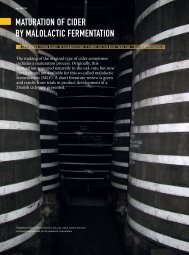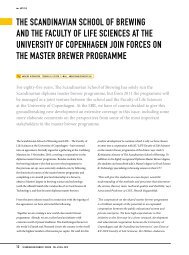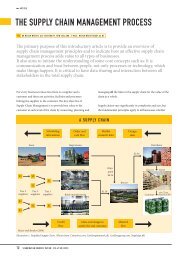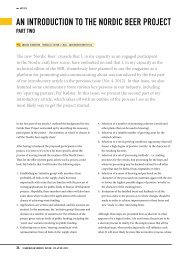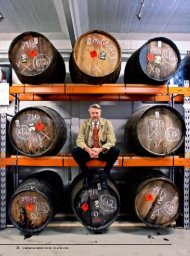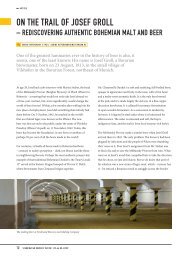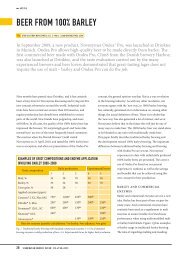The beer of The Danish GolDen aGe - Scandbrewrev.dk
The beer of The Danish GolDen aGe - Scandbrewrev.dk
The beer of The Danish GolDen aGe - Scandbrewrev.dk
You also want an ePaper? Increase the reach of your titles
YUMPU automatically turns print PDFs into web optimized ePapers that Google loves.
<strong>The</strong> <strong>beer</strong> <strong>of</strong> <strong>The</strong> <strong>Danish</strong> <strong>GolDen</strong> <strong>aGe</strong><br />
bled him to deduce a type <strong>of</strong> rule <strong>of</strong> the relationship between<br />
density, extract, and alcohol. His result corresponds quite well<br />
to the knowledge we possess today. He measured the <strong>beer</strong> with<br />
an alcohol percentage <strong>of</strong> 4.86 and a density <strong>of</strong> 1.048 to have an<br />
extract <strong>of</strong> 12 per cent, and the <strong>beer</strong> with an alcohol percentage<br />
<strong>of</strong> 3.47 and a density <strong>of</strong> 1.036 to have an extract <strong>of</strong> 9.5 per cent.<br />
‘On the basis <strong>of</strong> this, one can assume that a little more than one<br />
third per cent alcohol is obtained in the <strong>beer</strong> for each per cent<br />
<strong>of</strong> solids in the wort’. Expressed in slightly more modern terms,<br />
he explained that if one knew the percentage <strong>of</strong> extract in the<br />
wort (what we call original gravity and measure in degrees<br />
Plato), one could operate with a fairly reliable basic ratio be-<br />
tween this and the alcohol percentage <strong>of</strong> the final <strong>beer</strong>. It is still<br />
a rule <strong>of</strong> thumb that roughly one third <strong>of</strong> the extract turns into<br />
alcohol if one does not ‘fiddle’ with the enzymatic processes and<br />
adds ‘funny’ micro-organisms.<br />
Brøndum is <strong>of</strong> the conviction that if one ‘fermented for long<br />
enough and applied enough yeast,’ all sugar would be turned<br />
into carbonic acid and alcohol. However, it would not be a good<br />
idea, he points out, as the <strong>beer</strong> would not get the ‘proper taste’<br />
and would most likely turn sour. He is <strong>of</strong> course right in the<br />
latter, since acetic acid bacteria and other nice micro-organisms<br />
would take over the job from the yeast and throw themselves<br />
at the otherwise unfermentable carbohydrates. Moreover, he<br />
believes that ‘the distiller must strive to obtain as much alcohol<br />
from his mash as he can, whereas the brewer should only strive<br />
to produce a suitable amount <strong>of</strong> alcohol relative to the other<br />
ingredients <strong>of</strong> the <strong>beer</strong>’. An entirely culinary approach to the<br />
<strong>beer</strong>, which brings up the concept ‘flavour balance’ at an early<br />
point in the <strong>Danish</strong> history <strong>of</strong> <strong>beer</strong>.<br />
<strong>The</strong> mysTerious colour blindness<br />
Through history, the <strong>Danish</strong> ales have been provided with<br />
many imaginative, poetic, and technical names. But the two<br />
most commonly applied terms for historical top-fermented<br />
<strong>beer</strong> in our kingdom were quite trivially colour describing:<br />
brown <strong>beer</strong> and white <strong>beer</strong>. <strong>The</strong>se two terms were used as<br />
main categories in order to distinguish between all the brews in<br />
the large stream <strong>of</strong> <strong>Danish</strong> ale.<br />
And here, we have to hold on to our hats! Because it is vital<br />
to know that the brown <strong>beer</strong> could be strong or weak and the<br />
white <strong>beer</strong> could also be strong or weak. ‘White <strong>beer</strong>’ was not,<br />
18 SCANDINAVIAN BREWERS’ REVIEW . VOL.65 NO.4 2008<br />
then, an implicit label for strength, but a practical and logical<br />
identification on a colour chart.<br />
For obvious reasons, the term ‘hvidtøl’ has been a mystery to<br />
many contemporary Danes, and the mystery is still kept alive<br />
on the many <strong>Danish</strong> bottles <strong>of</strong> <strong>beer</strong> that contain weak, dark,<br />
and sweet top-fermented ale. One <strong>of</strong> this world’s many para-<br />
doxes in a <strong>beer</strong> industry which, over the years, has developed<br />
several bad habits semantically.<br />
Why in earth call an extremely dark ale ‘white’? Or even more<br />
stupid: call it a ‘dark white ale’? And utterly stupid: call it a<br />
‘pale white ale’? Mysterious practices which take place when<br />
linguistic colour blindness and a lack <strong>of</strong> historical knowledge<br />
controls the labelling and the marketing <strong>of</strong> the gradually more<br />
rare examples <strong>of</strong> pale top-fermented, tax-free ale.<br />
In order to understand why the brewers’ <strong>of</strong> the 19th century<br />
were so enthusiastic about the term ‘white’, we have to have a<br />
closer look at the period where new techniques within malt-<br />
ing had a revolutionary impact on brewing <strong>beer</strong> in the more<br />
advanced craft breweries. It was precisely at the end <strong>of</strong> the<br />
18th century and in the beginning <strong>of</strong> the 19th century that the<br />
Danes, in general, and the Copenhageners, in particular, had<br />
the opportunity to say goodbye to the brown, <strong>of</strong>ten smoke fla-<br />
voured <strong>beer</strong> and put transparent tumblers <strong>of</strong> considerably paler,



